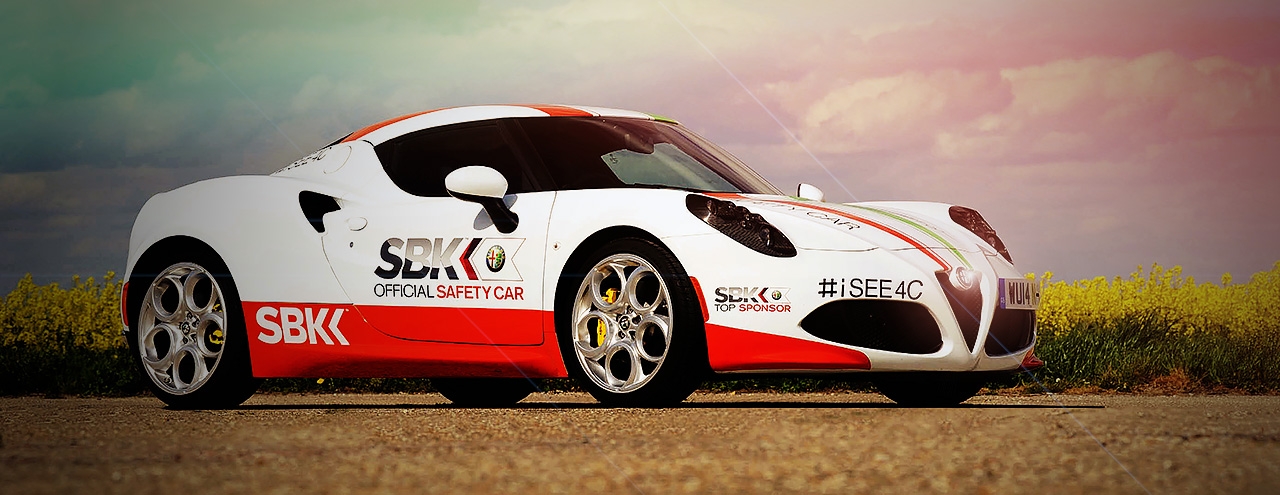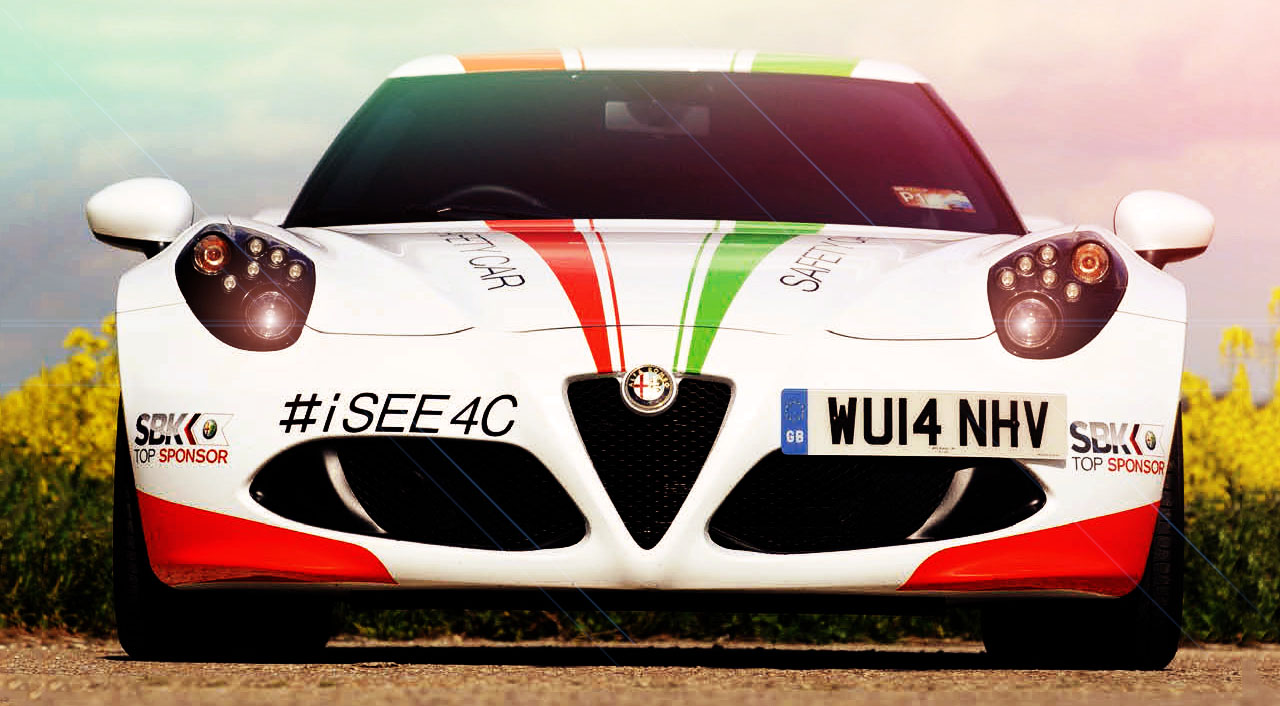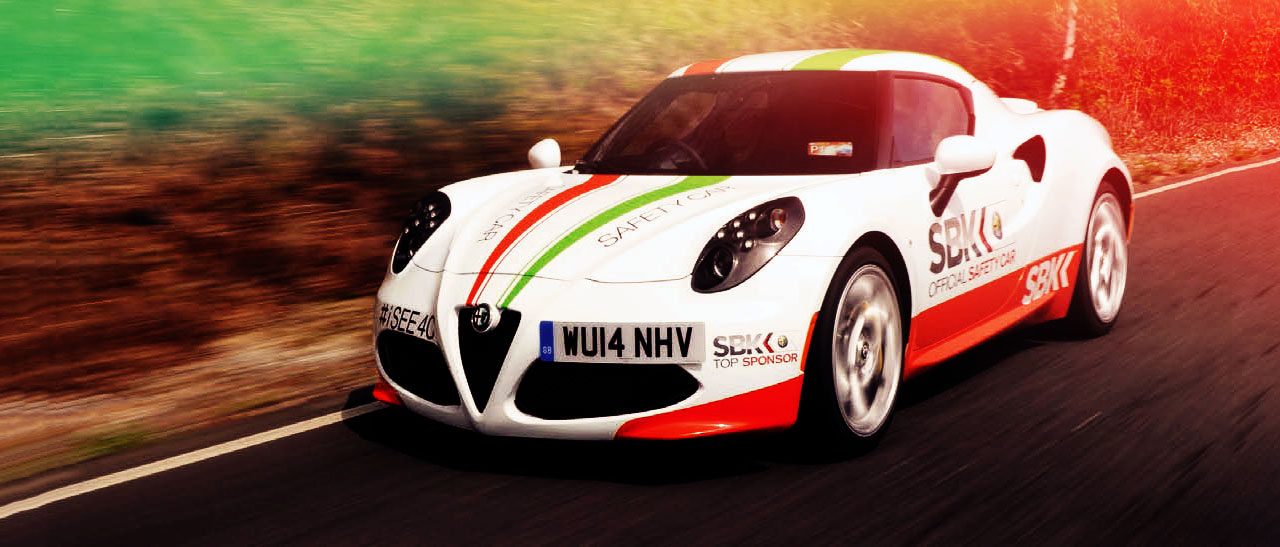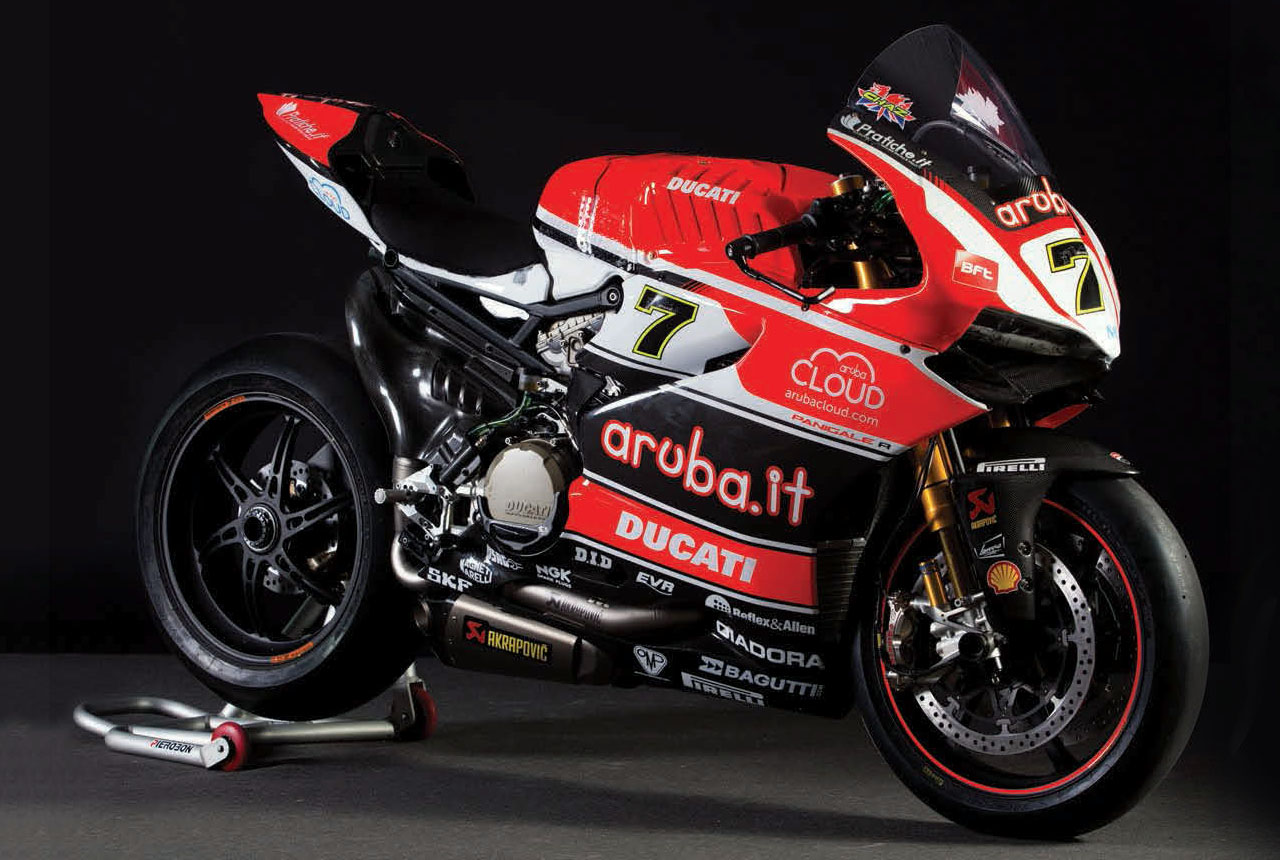
Alfa Romeo 4C SBK Italian bikes in the Superbike Championship. Forza Italia. We drive the Alfa Romeo 4C Superbike World Championship safety car and review the front running Italian bikes Story by Chris Rees and Alan Cathcart. Photography Michael Ward.
More than any other branch of motorcycle sport, the World Superbike Championship comes Made in Italy. Seventeen of the riders crowned World champion in the past 27 years, since the series kicked off in 1988, rode an Italian bike to the title, including four out of the past five seasons. There’s an even more pronounced Latin dominance when you look at the Manufacturers’ World Championship, in which Italian marques have been utterly dominant with 21 title victories versus their Japanese rivals led by Honda with just four championship crowns, Kawasaki with two, and Yamaha and Suzuki with just one each. Forza Italia! Since an Alfa 4C is running as the safety car in the Superbike World Championship (SBK) superbike series, when we got the call to ask if we wanted to drive this very car, we had the perfect task for it, as it turned out. We were in need of our own pace car for the action around the Brooklands Mercedes-Benz World circuit at the recent Italian Car Day – what better machine could there be than the SBK 4C?

ABOVE: In track day mode, the 4C is a fantastic companion, incisive around sharp twists and easy to drive quickly.
Well, that’s what I was thinking up until the moment when, due to a slight mix-up at Marshal HQ, the 4C was waved out instead of Editor Phil’s Ferrari as the pace car for one of the fastest groups of the day. Next thing I knew, my rear-view mirror was suddenly filled with the highly intimidating sight of Oakley’s satin-chrome green-wrapped Lamborghini Huracán.

Hitting the long straight heading away from the main building, and extending the 4C’s legs fully for the first time, it came as no surprise that The Green Hulk remained glued to the Alfa’s bumper. Quick the 4C certainly is in a straight line, but there was no way a four-cylinder 4C with 240bhp was going to outpace a tuned V10 with 680bhp on this section of the track. But after the first corner, the circuit at Mercedes-Benz World becomes not only very narrow, but very twisty too, with several hairpin bends in a row. Here, the 4C comes into its element. Its slender girth, fast steering and nimble turn-in make it the ideal tool to eat up the kart-track-like corners. It carves through the circuit with an easy flow, keeping in a low gear and letting the turbo torque carry us cleanly through each apex.

I refrain from engaging ‘Race’ mode on the DNA switch, as the short wheelbase and snappy bite of the mid-engined chassis has been known to, er, catch out the unwary. And as we’re nominally the safety car, spinning off into the kitty litter here would be extremely embarrassing.

Where does this experience leave me on the subject of the 4C, then? Well, I continue to cleave to my view that the 4C is a highly talented sportscar, but it’s somewhat stuck between two stools – neither comfortable enough to be a practical everyday car, nor focused enough to compete with Lotus. However, in its track task today, it’s been a fantastic companion: incisive around the sharp twists, and easy to drive quickly. Just don’t ask me to pace a tuned Lambo again…
THE BIKES
The Italian presence on World Superbike grids is presently shared between three different marques, Aprilia, Ducati and MV Agusta – each with a different solution to how best to build a race-winning high performance motorcycle. France’s reigning World champion Sylvain Guintoli won his title last year on an Aprilia RSV4 from Noale (north of Venice) powered by a narrow-angle 65º V4 engine measuring 78mm x 52.3mm for 999.6cc, and producing over 240bhp at 15,000 rpm at the gearbox. Those numbers are worthy of the anything-goes MotoGP grid, but as part of the giant Piaggio scooter group Aprilia plays it strictly by the rules.
“Back in 2005 Piaggio decided to go Superbike racing,” says Aprilia’s Direttore Tecnico, Romano Albesiano, “so I sat down with a colleague to make a list of features we needed to include on the production streetbike that would help make the Superbike race version competitive.”

“The philosophy of the RSV4 is that it’s a racebike with lights that any customer can buy at a reasonable cost and ride to the shops on, but which has the basis to be turned into a championship-winning racebike in full compliance with SBK rules. We set out to produce a great streetbike which gave birth to a Superbike racer that’s fully compliant with the rules, and has now proved three times it’s the best Superbike money can buy.”
Indeed so, yet despite having won three World Superbike titles in the past five years courtesy of Guintoli and two-time champion Max Biaggi, Aprilia’s V4 is still outsold better than ten to one by Ducati V-twins in the showroom GP, and even plays second fiddle there to the much smaller but undoubtedly more glorious MV Agusta marque.
The so-called Ferrari of motorcycles with 270 Grand Prix victories and 75 World Championship titles in its locker, including 17 successive 500GP crowns, Varese-based MV Agusta is very much back in business both in the showroom and on the racetrack, aiming to pick up where it left off four decades ago, when Phil Read won MV Agusta’s final 500cc World Championship crown in 1974.
For the first time in 39 years, since the day the music died in 1996 when new FIM noise regulations forced the firm with the last four-stroke on the Grand Prix grid to retire from racing, the MV Agusta factory is now a serious contender for a 76th World title. That comes thanks to the three race victories in the World Supersport support class catering for 600cc fours and 675cc triples like the MV Agusta F3, that have been notched up so far in 2015 by its French rider Jules Cluzel aboard the small, svelte Italian bike. But for two DNFs in other rounds when decisively leading the race – a problem traced to a faulty batch of valve springs – Cluzel would be easily leading the World Supersport points table. But he’s in second place and closing on Turkey’s reigning champion, hard-riding Kawasakimounted Kenan Sofuoglu with three rounds to go.
MV Agusta is also competing in the World Superbike category with a single in-line four-cylinder F4RR ridden by Leon Camier, a former British Superbike champion who usually manages lower top ten finishes. This is due to riding an underpowered bike that’s very much a laboratory on wheels, busily gathering data for an allnew high performance F4 that’ll be launched a year from now, when MV’s main focus will surely switch from Supersport to Superbike. Indeed, it’s likely that reigning Formula 1 world champions Mercedes-Benz will be offering advice to MV Agusta on how to build a better such bike, having purchased a 25% minority shareholding in the Italian trophy marque last October through its AMG subsidiary.
“It doesn’t often happen that an industrial giant buys a minority stake in a family-owned business,” says MV’s youthful owner Giovanni Castiglioni, “but that’s what has happened here, and it’s a fine implied compliment that Mercedes-Benz consider us to be a sufficiently well-run company that they should pay good money to acquire a minority stake in MV.”
Superbike’s equivalent of MV Agusta in terms of dominance down the years is Ducati – but when its then-reigning World champion Carlos Checa rode his desmo V-twin 1098R to victory at the USA’s Miller Motorsports Park in May 2012, you’d have got long odds against it being another 74 races and three years short of a month before a Ducati-mounted rider would win another World Superbike race. But that’s how long it took for the Italian marque’s 90º V-twins with desmodromic valve gear to start winning again, after the longest dry spell in its glorious Superbike racing history spanning 27 years, 14 Riders’ world titles and 17 Manufacturers’ crowns. But Britain’s Chaz Davies finally took Ducati back to the top step of the rostrum again in the third round of the 2015 series at Aragon in Spain. He did so aboard the bike that until then had failed to deliver on expectations, the radical 1199 Panigale with its ultra shortstroke Superquadro motor, which had so far been out raced in the World Superbike series by the fleet of fast fours it had so repeatedly trounced in days gone by.
But Welshman Davies has turned that record of non-achievement on its head, dominating the second race at Aragon in April to take what must surely have been the sweetest of victories for Ducati’s Superbike Project Director, Ernesto Marinelli, and his hard-working team of technicians at Ducati’s Borgo Panigale factory in Bologna – yes, hence the name. And with four race victories so far in the first ten rounds of the 2015 series – including a double win at the Laguna Seca round held in Ducati’s No.1 market for its customer streetbike models, the USA – it seems Davies may just have turned the page for the Panigale, and Ducati.
That’s partly come about thanks to a radical shakeup in the World Superbike regulations for 2015, aimed at reducing costs by returning the category closer to its roots, and making the racebikes on the starting grid closer to the street motorcycles they’re derived from. So the reigning World champion Aprilia has had its performance severely reined in by as much as 25bhp or more than 10%, while Ducati’s response to this was to launch a revamped version of its Panigale R homologation special, a true racer with lights, a horn and a licence plate of which at least 1000 examples will be made this year for customer sale. Its specification includes many features which Ducati deemed its racer needed, including a lighter crankshaft, titanium valves and conrods, etc. in the 1198cc Superquadro engine, whose name signifies its oversquare 112m x 60.8mm dimensions, the most extreme of any current production bike. Compare that to the 106mm x 67.9mm format of the same-capacity 1198 model it replaced three years ago, the last in the line of desmoquattro Ltwins whose life story began exactly 28 years ago in 1987 with the debut of the first-ever Ducati Superbike, the 851, and won the World title with Carlos Checa in its final season at the races in 2011.
“Last year the biggest problem we had was to keep up with the acceleration of the four-cylinder bikes,” says Ernesto Marinelli. “So our development of the engine under the new rules has been focused on this, and with the lighter crankshaft we were able to improve that, together with the other work we did on the exhaust with Akrapovič, where they managed to significantly improve the bottom end performance. On top power we are now more or less the same as the fours with 205bhp at 11,500 rpm, and on the chassis geometry we wanted to try to make the bike as stable as possible while also accelerating harder for the first punch out of the corner, so this year we’ve lengthened it more compared to last year, for extra stability.” You don’t have to be an ardent Ducatista to welcome Ducati’s return to the front of the field in World Superbike, because the sight and sound of the red Vtwins challenging the screaming Japanese in-line fours for victory is a key ingredient in the category’s fan appeal. Long may it continue!
BELOW: The SBK safety car takes time off from the bike championship to carry out Brooklands duties.






